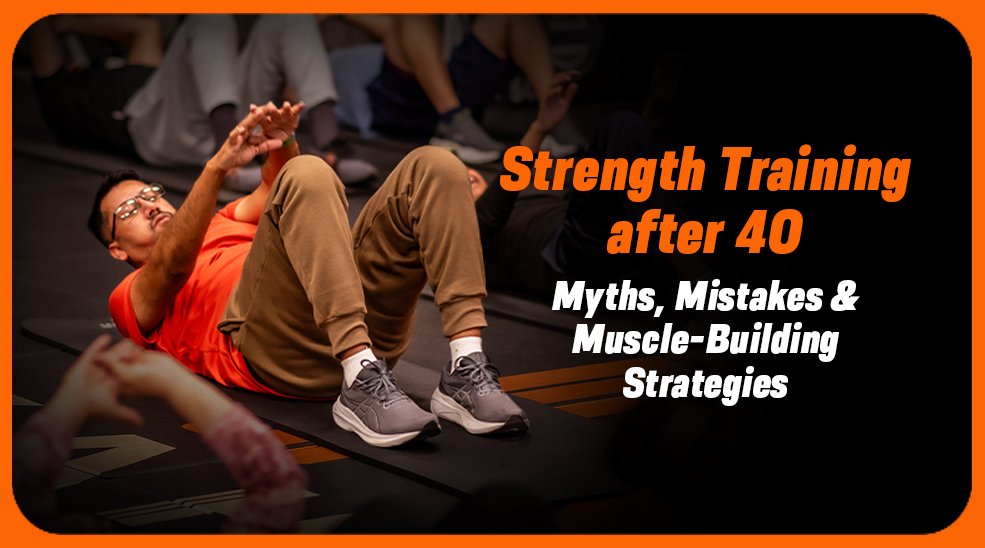ALWAYS OPEN! WE WORK 24/7

At 40 (and older), strength training preserves muscle, bone, range of motion and independence. As studies supported by the U.S. National Institute on Aging have found, resistance training maintains strong muscles, improves functioning, and accrues healthy years of life.
Myth 1: "It's too late to build muscle."
Fact: When resistance training begins in older persons makes no difference; they will get stronger and bigger as long as they continue it and eat enough protein.
Myth 2: "Light weights, high reps are the only safe thing."
Fact: Progress is defined by increasing-effort sets. Expert guidance allows a wide rep range—as long as sets are challenging and progressively loaded.
Myth 3: "Supplements replace training and diet."
Fact: Supplements will aid gains, but won't replace progressive strength training and adequate protein.
No progress: Constantly not lifting the same weight forever turns off gains. Increase load 2–10% when you can perform more than your desired number of reps with good form.
Insufficient frequency: Training major muscles every week slows gains. Two to three full-body workouts are best for most adults' needs.
Not eating enough protein: Most adults are under the intake linked to increased strength and hypertrophy. Target evidence-based levels (below).
H3-1) Training: the weekly plan
Frequency: 2–3 full-body sessions/week (e.g., Mon/Wed/Fri). This meets guidelines for adults and allows enough recovery time.
Core exercises: either leg press/squat or hip hinge (deadlift or hip thrust); horizontal push (bench/push-up); horizontal pull (row); vertical push (overhead press); vertical pull (lat-pull/chin-up); calf and core options;
Volume & intensity: 2–4 hard sets per exercise and not quite to failure most of the time. Add small amounts of load or reps each week (progressive overload) if performance is allowing.
Mobility & power: Add 5–10 minutes of movement prep and a few low-grade power drills (e.g., med-ball throws) to maintain some speed and co-ordination in older age. (This is consistent with a resistance training approach to functional abilities.)
If you would like a coach to develop this for your needs or potential previous injuries, look for a personal training Clyde North and then use a qualified professional, who knows how to periodize your plan to get the courseload and also break down technique.
H3-2) Protein: how much and how to take it
Target daily: Meta-analyses refer to a figure of approximately 1.6 g protein/kg body weight per day to maximally stimulate lean mass gains with resistance exercise; gains usually plateau higher than that for most people, although there are some who are able to do well up to ~2.2 g/kg/day.
Distribution: Disperse Space protein 3–4 times with ~0.4–0.5 g/kg per meal, to benefit from muscle protein synthesis stimulation multiple times a day. A before-bed protein snack can cover nighttime.
Timing: Timing of whole-day protein is most critical; protein timing post-exercise is a convenient surrogate.
H3-3) Creatine & smart supplementation
Creatine monohydrate is the most studied supplement. In older persons, creatine supplementation along with resistance training when compared to training alone has a tendency to augment lean mass and strength gains. Dosage is 3–5 g/day (with optional short loading period).
Other supplements have mixed evidence; start with food first, then add targeted options as needed. If you’re researching supplements Clyde North, ask for third-party-tested products and guidance from a qualified coach or dietitian.
H3-4) Recovery habits that matter more after 40
Sleep: Aim for 7–9 hours—repair processes and training adaptations depend on it.
Control joint & tendon stress: Use controlled tempo, full range of motion you can control, and slow progression to respect connective tissues.
Cardio alongside lifting: 1–2 moderate classes or brisk walks on non-lifting days enhance recovery and cardiovascular fitness without interfering with strength. (Meets general adult physical activity guidelines.)
If you're already comparing options for a new gym Clyde North, don't accept equipment access as enough. Opt for a centre that also offers:
Official onboarding or test sessions – so you know what weights to start with and how to progress safely.
Qualified & experienced trainers who understand age-related exercise — not body building routines for 20-year-olds.
Membership types which facilitate regular training rather than tying you into unrealistic plans.
Well-equipped free weight areas (squat racks, cable machines, dumbbells up to higher ranges), as machines alone aren’t enough for full muscular development.
Combine this with reputable supplements Clyde North providers — ideally ones that offer third-party tested protein powders, creatine, or joint-support formulas — and you’ll have everything needed to support long-term muscle recovery and performance.
The science doesn't lie: lifters in their 40s, 50s, and beyond can gain strength just as easily as younger weightlifters when they follow a structured program. The majority of adults are actually better off building strength later in life because they are more stable, more disciplined, and more focused.
Coupling science-based progressive strength training, correct protein nutrition, and evidence-based supplements with the guidance of personal training Clyde North professionals gives you a strategic advantage — not just for muscle gain, but for staying independent, active, and confident for the next decades.
You are not exercising for appearance alone — you are strength training for longevity, mobility, and quality of life. And it is this that empowers your transformation more than ever.